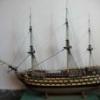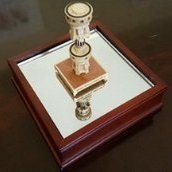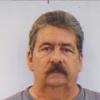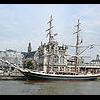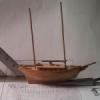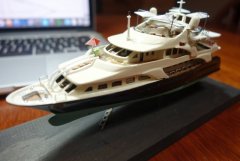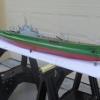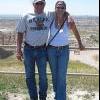Supplies of the Ship Modeler's Handbook are running out. Get your copy NOW before they are gone! Click on photo to order.
×
-
Posts
4,873 -
Joined
-
Last visited
Reputation Activity
-
 gjdale got a reaction from Nirvana in Schooner Polotsk 1777 by Mike Y and his daughter - Master Korabel - 1:72
gjdale got a reaction from Nirvana in Schooner Polotsk 1777 by Mike Y and his daughter - Master Korabel - 1:72
Nice progress Daria. Good to see you wearing the proper safety gear too!
-
 gjdale got a reaction from mtaylor in Schooner Polotsk 1777 by Mike Y and his daughter - Master Korabel - 1:72
gjdale got a reaction from mtaylor in Schooner Polotsk 1777 by Mike Y and his daughter - Master Korabel - 1:72
Nice progress Daria. Good to see you wearing the proper safety gear too!
-
 gjdale reacted to Sjors in HMS Agamemnon by Sjors - FINISHED - Caldercraft/Jotika - 1:64
gjdale reacted to Sjors in HMS Agamemnon by Sjors - FINISHED - Caldercraft/Jotika - 1:64
Thanks Sam !
But as you know it your self, sometimes the life is in the way.......
But.....a week later then I was saying but here is an update.
Anja finished 3 of the 6 hammock netting....
Still 3 to go and in the mean time I have make the spar/ yards for the front mast.
And place them !
Pictures of that are following.
Tomorrow I go to the spars/yards for the main mast.
Before any questions are coming.....yep, I place them without ropes or parrel beats or other kind of stuff.
I'am a little sneaky and I know it's not the way but for me it works just fine.
I drill a 1 mm hole in to the mast and spar and glue a brass wire of 1 mm inside.
You don't see a thing of it and I can work on the spars/yards without moving that thing !
Blame me if you want
Sjors
-
 gjdale reacted to garyb in Swan-Class Sloop by garyb - 1:48
gjdale reacted to garyb in Swan-Class Sloop by garyb - 1:48
Hi All
Just been comparing my drawings off the head stern and deadwood with the pdf's Ben sent me (Thanks again Ben ) and they match almost perfectly so must be doing some thing wright. So have made a start cutting out the paper patterns. There are so many its easy to see why these sort of models take so long. For a bit of a change I tried laying some off the parts out to get the best layout for glue on the timber.
Yours Gary
-
 gjdale got a reaction from John Allen in Licorne 1755 by mtaylor - 3/16" scale - French Frigate - from Hahn plans - Version 2.0 - TERMINATED
gjdale got a reaction from John Allen in Licorne 1755 by mtaylor - 3/16" scale - French Frigate - from Hahn plans - Version 2.0 - TERMINATED
Looking good Mark. Sorry to hear of Janet's health issues - best wishes to you both for improvement there.
-
 gjdale got a reaction from Canute in Licorne 1755 by mtaylor - 3/16" scale - French Frigate - from Hahn plans - Version 2.0 - TERMINATED
gjdale got a reaction from Canute in Licorne 1755 by mtaylor - 3/16" scale - French Frigate - from Hahn plans - Version 2.0 - TERMINATED
Looking good Mark. Sorry to hear of Janet's health issues - best wishes to you both for improvement there.
-
 gjdale got a reaction from hexnut in Licorne 1755 by mtaylor - 3/16" scale - French Frigate - from Hahn plans - Version 2.0 - TERMINATED
gjdale got a reaction from hexnut in Licorne 1755 by mtaylor - 3/16" scale - French Frigate - from Hahn plans - Version 2.0 - TERMINATED
Looking good Mark. Sorry to hear of Janet's health issues - best wishes to you both for improvement there.
-
 gjdale got a reaction from Chasseur in Licorne 1755 by mtaylor - 3/16" scale - French Frigate - from Hahn plans - Version 2.0 - TERMINATED
gjdale got a reaction from Chasseur in Licorne 1755 by mtaylor - 3/16" scale - French Frigate - from Hahn plans - Version 2.0 - TERMINATED
Looking good Mark. Sorry to hear of Janet's health issues - best wishes to you both for improvement there.
-
 gjdale got a reaction from cog in Licorne 1755 by mtaylor - 3/16" scale - French Frigate - from Hahn plans - Version 2.0 - TERMINATED
gjdale got a reaction from cog in Licorne 1755 by mtaylor - 3/16" scale - French Frigate - from Hahn plans - Version 2.0 - TERMINATED
Looking good Mark. Sorry to hear of Janet's health issues - best wishes to you both for improvement there.
-
 gjdale got a reaction from Omega1234 in Licorne 1755 by mtaylor - 3/16" scale - French Frigate - from Hahn plans - Version 2.0 - TERMINATED
gjdale got a reaction from Omega1234 in Licorne 1755 by mtaylor - 3/16" scale - French Frigate - from Hahn plans - Version 2.0 - TERMINATED
Looking good Mark. Sorry to hear of Janet's health issues - best wishes to you both for improvement there.
-
 gjdale got a reaction from FriedClams in Licorne 1755 by mtaylor - 3/16" scale - French Frigate - from Hahn plans - Version 2.0 - TERMINATED
gjdale got a reaction from FriedClams in Licorne 1755 by mtaylor - 3/16" scale - French Frigate - from Hahn plans - Version 2.0 - TERMINATED
Looking good Mark. Sorry to hear of Janet's health issues - best wishes to you both for improvement there.
-
 gjdale got a reaction from Piet in Licorne 1755 by mtaylor - 3/16" scale - French Frigate - from Hahn plans - Version 2.0 - TERMINATED
gjdale got a reaction from Piet in Licorne 1755 by mtaylor - 3/16" scale - French Frigate - from Hahn plans - Version 2.0 - TERMINATED
Looking good Mark. Sorry to hear of Janet's health issues - best wishes to you both for improvement there.
-
 gjdale got a reaction from Jack12477 in Licorne 1755 by mtaylor - 3/16" scale - French Frigate - from Hahn plans - Version 2.0 - TERMINATED
gjdale got a reaction from Jack12477 in Licorne 1755 by mtaylor - 3/16" scale - French Frigate - from Hahn plans - Version 2.0 - TERMINATED
Looking good Mark. Sorry to hear of Janet's health issues - best wishes to you both for improvement there.
-
 gjdale reacted to mtaylor in Licorne 1755 by mtaylor - 3/16" scale - French Frigate - from Hahn plans - Version 2.0 - TERMINATED
gjdale reacted to mtaylor in Licorne 1755 by mtaylor - 3/16" scale - French Frigate - from Hahn plans - Version 2.0 - TERMINATED
Thanks for the comments, the "likes" and just looking in...
At last, a real update as life (the Admiral's health) got in the way. The frame extensions have been removed and she's starting to look more like a frigate. I still need to sand them down to the sheer strake but I'll be doing that when I need a break from the gundeck work.
Here's the pictures... as always, a click on them will open them to full size (or what constitutes full size on MSW). The last two are more of a reference shot for examining things on my part but I thought I'd toss them in anyway. Sorry about the sawdust and mess.....
-
 gjdale reacted to realworkingsailor in HMS Diana by realworkingsailor (Andy) - Caldercraft - 1:64
gjdale reacted to realworkingsailor in HMS Diana by realworkingsailor (Andy) - Caldercraft - 1:64
Update time! Hooray!
Planking continues slowly and steadily on the starboard side. The second layer of the wale has been added, my first attempt at top and butt (anchor stock). You can just see the shape of the planks through the black paint. I used castello boxwood for the second layer, which was a pleasure to work with. Having the black strake 0.5mm proud of the surrounding planking gave a nice line for the first strake to butt up against.
Below the wales, I've carried on using the kit supplied walnut planking. It is incredibly splintery, Caldercraft must supply some other variety of walnut from that supplied by Amati (go figure). It works after a fashion, and doesn't look too bad. Most of it will be coppered anyway, and I find the the colour contrast to the castello appealing. Also, because the kit supplied planks are also about 1m long, cutting them down to more manageable lengths has made things a lot easier when it comes to bending and tapering, it also makes it easier to get a nice fit and finish where the planks meet the stem and stern counter.
Anyway, that's about it for now
Andy
-
 gjdale reacted to Mirabell61 in SS Kaiser Wilhelm der Grosse 1897 by Mirabell61 - FINISHED - scale 1:144 - POF - first German four stacker of the Norddeutscher Lloyd line
gjdale reacted to Mirabell61 in SS Kaiser Wilhelm der Grosse 1897 by Mirabell61 - FINISHED - scale 1:144 - POF - first German four stacker of the Norddeutscher Lloyd line
Update....
handrail for deck housing and halfround light shaft dome windows...
Nils
-
 gjdale reacted to Jeronimo in THE 74-GUN SHIP by Jeronimo
gjdale reacted to Jeronimo in THE 74-GUN SHIP by Jeronimo
Hello friends,
after about two years of construction I make a provisional building model on the "74 GUN-SHIP".
The occasion is the construction and testing of a completely different ship type.
See new topic in forum MSW.
(Sorry Google Translator)
Hallo Freunde,
nach ca. zweijähriger Bauzeit mache ich an dem Modell "74 GUN-SHIP" einen vorläufgen Baustop.
Der Anlass ist der Bau und "Versuch" eines ganz anderen Schiffstypes.
Siehe demnächst neue Topic bei MSW.
Gruss Karl
-
 gjdale reacted to Mike Y in Beavers Prize 1777 by Mike Y - 1:48 - POF - Hahn style
gjdale reacted to Mike Y in Beavers Prize 1777 by Mike Y - 1:48 - POF - Hahn style
Spent the last few weekends procrastinating, working on a workbench improvements.
It all started with a problem of fixing wooden boards to the table. Clamps are not really good enough, especially if you start planing. But any sort of bench vice is too ugly for the living room, and there is a door to the kid room right next to the table - so it is not convenient to have a large handle.
And then I discovered Veritas inset vice. Yes, that was perfect for the purpose! Nice, elegant, small handle.
To install it, a large mortise needs to be made in the table top. Started with drilling away most of the material.
The rest was removed with a router bit and dremel. Routing freehand is super scary! But works:
Then a small "frame" was made with a miniature router plane and a block plane:
I severely underestimated the efforts required to make a mortise with the tools I have. It took too many hours and too much dust
Since my table top is not thick enough (not enough wood left under the mortise) I reinforced it with thick plywood located under the vice, fixed to the table top with glue and lots of thick dowels:
Done! It is flush with the surface (I even made it 1mm below the surface), and the handle is unlikely to be a problem even on a way to the kid room:
When used, bench dog (hand made) is inserted into a hole, and a small jaw is inserted into the vice:
Uses are many. Starting from fixing the model in a jig (very little pressure is required, so I do not think the jig or hull will deform):
Ending with planing the wood. This beautiful walnut board with epoxy-filled cracks was waiting for the vice to be planed. Finally done!
-
 gjdale reacted to Mirabell61 in SS Kaiser Wilhelm der Grosse 1897 by Mirabell61 - FINISHED - scale 1:144 - POF - first German four stacker of the Norddeutscher Lloyd line
gjdale reacted to Mirabell61 in SS Kaiser Wilhelm der Grosse 1897 by Mirabell61 - FINISHED - scale 1:144 - POF - first German four stacker of the Norddeutscher Lloyd line
small update....
this little structure sits up on the boats deck between 2 nd. and 3 rd. funnel.
This is the position where the large 1 st class dining lounge is situated over several decks across the whole width of the ship, because here no stackshafts interfere with the dining area.
The half round stucture will be modeled to the light dome of the dining lounge comprising about 30 single little "glassed" frames
Nils
-
 gjdale reacted to rafine in Granado by rafine - FINISHED - Caldercraft - 1:64
gjdale reacted to rafine in Granado by rafine - FINISHED - Caldercraft - 1:64
Work on the mainmast standing rigging has been progressing over the past week. This has involved doing the ratlines on the port side, finishing the topmast running and breast backstays on both sides, adding the topmast stay and staysail stay, adding the lead blocks at the topmast head for the topsail jeers and the lifts/sheets, and doing the jib stay.
The ratlines were done like the starboard side previously done.
The running and breast backstays had been previously mounted at the masthead, and were now set up to their deadeyes at the channels.
The topmast stay was fitted with a staysail stay seized to it as shown in AOTS and described in Lees (no staysail stay is shown on the kit plans). Both of these were led through the bees and set up with tackles at the bow.
The jib stay is not shown on the kit plans and, again, was done with reference to AOTS and Lees.The head of the stay is led through a block at the topmast cap, which Lees describes as appropriate for the period of Granado's construction. Subsequently, a cheek block at the masthead would have been used. The forward end is attached to a traveler on the jibboom. The traveler was made in accordance with Lees, and consists of a wire ring, a small wooden thimble, a brass shackle and a brass hook. The stay is seized to the thimble, the outhauler is seized to the shackle and then led through the sheave in the jibboom and back to the bow with a tackle. Later, the halyard/ downhauler will be attached to the hook. The running end of the stay is led down to the channels and tied off to a deadeye.
Now, it's on to the main topgallant mast and rigging and doing the mizzen ratlines.
Bob
-
 gjdale got a reaction from hamilton in 1949 Chris-Craft 19' Racing Runabout by gjdale - FINISHED -Dumas - 1:8 Scale - RADIO
gjdale got a reaction from hamilton in 1949 Chris-Craft 19' Racing Runabout by gjdale - FINISHED -Dumas - 1:8 Scale - RADIO
Thanks again folks for all the kind comments and the "likes" - they really encourage me to keep striving.
A fairly major update today as I've completed manufacturing all the parts for the new steering wheel.
Wheel Building continued - the Hubs
If I thought that the hard part was over …..
The first step was to actually design my hub components. Although Kip had very kindly sent me a copy of his “chook scratchings” from the design process, I needed to make a couple of design changes to suit my slightly different approach (primarily the fact that the steering shaft will thread into the rear hub). I had several exchanges of email with Kip throughout this process and that was a huge help in getting my head around the task. Here is a copy of my own early chook scratchings.
From here, I decided to make up a set of CAD drawings of each component to further understand what I was attempting to do, and also as a useful check on my own measurements and calculations. Needless to say, there were many changes to both this diagram and the CAD drawings as the manufacturing process got underway – “no plan, no matter how good, survives first contact with the enemy!”
Once I had the design principles clearly in my head, the manufacturing process actually went quite smoothly…….for the most part. In fact, it went so well that I forgot to take many progress shots. In the next picture, I am drilling the banjo spoke holes into what will become the banjo spoke hub. This started as a piece of 5/8” brass rod, that was first bored to leave a wall thickness of 1.5 mm. The banjo spoke holes are all 0.5 mm in diameter and I managed to drill all twelve without breaking the drill bit. Ironically, the drill bit broke just as I was removing it from the mill.
The manufacturing process required some thought as to how to hold various pieces on the lathe while they were being turned and shaped and fitted to their final dimensions. After a bit of trial and error, I concluded that several mandrels of various key sizes, both solid and centre-bored, were the most useful thing to use. I found that gluing these temporarily with CA to the stock being machined held the piece securely while being worked. The parts were then separated by the judicious application of heat from the MAPP blow torch. Here is a shot of the various mandrels I used – in some cases a combination of two mandrels were required.
The rear hub was shaped by first cutting a series of steps (staircase effect) and then smoothing with a round file while still on the lathe. The Horn Ring Hub, Trim Piece and Cap piece required a radius on the end. The Radius Cutting attachment for the lathe worked a treat for these parts.
The Horn Ring itself is square in section and this was formed by using a 1/16” square brass tube. After first annealing with the MAPP torch, it was bent around the same wooden buck as used for the wheel rim. The buck was first turned down to the appropriate diameter, and I must confess here to having a couple of goes at this before I was satisfied with the size. As the tube is hollow, it allowed me to insert a piece of 0.8 mm brass rod inside and extending across the join. This really helped when silver-soldering the join closed. The piece was then returned to the rotary table on the mill and 0.85 mm holes were drilled at 120 degree intervals for mounting the spokes.
The spokes for the horn ring are also square in section and the same brass tube was used for this. By inserting a piece of the 0.8mm brass rod through the pre-drilled hole in the horn ring, right through the length of the spoke, and into the horn ring hub, the hole assembly becomes self-aligning.
The horn ring hub itself was probably the most difficult of all of these parts to make and I had three attempts at this before I was finally satisfied.
The Cap Piece, as well as having a radius turned on the end, also had a 1/32” slot cut with a slitting saw to receive the Throttle Lever, which itself was cut and filed from a piece of 1/32” brass flat bar.
The picture below shows all of these parts, starting with the Wheel Rim and a selection of banjo spokes at the rear, the Horn Ring, Horn Ring Hub and Horn Ring Spokes (temporarily mounted and ready for soldering), and then across the front from left to right are the Rear Hub (note the internal threading to receive the steering column), the Banjo Spoke Hub, the Trim Piece, and the Cap Piece, with the Throttle Lever in the foreground.
Putting some of these components together for the camera, here is a of shot of the Horn Ring assembly mounted on the Banjo Spoke Hub, mounted on the Rear Hub, with a temporary Steering Shaft.
And lastly, the same assembly with the stainless-steel sleeve that goes over the steering shaft.
That completes the manufacture of all components for the new steering wheel. The next job will be to solder the Horn Ring assembly together, and then chrome plate the Horn Ring assembly, Cap Piece and Throttle Lever. The other components will be painted an off-white (ivory) colour, and then the whole lot will be finally assembled.
Once that is done, I will return attention to making the cutwater….
-
 gjdale got a reaction from Retired guy in 1949 Chris-Craft 19' Racing Runabout by gjdale - FINISHED -Dumas - 1:8 Scale - RADIO
gjdale got a reaction from Retired guy in 1949 Chris-Craft 19' Racing Runabout by gjdale - FINISHED -Dumas - 1:8 Scale - RADIO
The spoke holders were cleaned up and given a bit of shape by filing. Here is a shot of the completed spoke holders, with spokes fitted in one (temporarily).
The next job was to solder them to the wheel rim, again using silver solder. To hold them in the correct position, a shim of scrap aluminium 1/32” thick was shaped and drilled to accept some pins. Here is a shot of the soldering set-up.
The first two spoke holders went on just fine, but the third one didn’t want to play nice. However, sheer bloody-mindedness and determination won the day in the end. While I was at it, I re-did the main rim joint as well, as there was a slight misalignment that had been bugging me. To protect the soldered joints from de-soldering while the next joint was heated, I used a heat barrier call Cool Gel, made by LA-CO. It comes in a spray bottle, but I just squirted a bit onto the soldering mat and used an old paint brush to pick up and apply the gel to joints to be protected. This was the first time I’d used this and it works really well.
Here are a couple of shots of the completed joints. I’ve included the spokes in one of them to give an indication of how they will look once they are all together. They have been given an initial clean-up, but I may go back and do some more yet.
-
 gjdale reacted to Moonbug in 1949 Chris-Craft 19' Racing Runabout by gjdale - FINISHED -Dumas - 1:8 Scale - RADIO
gjdale reacted to Moonbug in 1949 Chris-Craft 19' Racing Runabout by gjdale - FINISHED -Dumas - 1:8 Scale - RADIO
Having little to no talent for metal work - this is all very impressive to me!
Nicely done Grant.
-
 gjdale reacted to Navis Factorem in HMS Surprise by Navis Factorem - FINISHED - 1:75
gjdale reacted to Navis Factorem in HMS Surprise by Navis Factorem - FINISHED - 1:75
25' Cutters
The "Blue" cutter has been completed and the hull for the "Red" cutter built. I was quite pleased to have been able to preserve the blank from the first cutter so I have a reasonable chance of ending up with 2 boats which should look reasonably similar.
Cheers,
David.
-
 gjdale got a reaction from Shazmira in 1949 Chris-Craft 19' Racing Runabout by gjdale - FINISHED -Dumas - 1:8 Scale - RADIO
gjdale got a reaction from Shazmira in 1949 Chris-Craft 19' Racing Runabout by gjdale - FINISHED -Dumas - 1:8 Scale - RADIO
Thanks again folks for all the kind comments and the "likes" - they really encourage me to keep striving.
A fairly major update today as I've completed manufacturing all the parts for the new steering wheel.
Wheel Building continued - the Hubs
If I thought that the hard part was over …..
The first step was to actually design my hub components. Although Kip had very kindly sent me a copy of his “chook scratchings” from the design process, I needed to make a couple of design changes to suit my slightly different approach (primarily the fact that the steering shaft will thread into the rear hub). I had several exchanges of email with Kip throughout this process and that was a huge help in getting my head around the task. Here is a copy of my own early chook scratchings.
From here, I decided to make up a set of CAD drawings of each component to further understand what I was attempting to do, and also as a useful check on my own measurements and calculations. Needless to say, there were many changes to both this diagram and the CAD drawings as the manufacturing process got underway – “no plan, no matter how good, survives first contact with the enemy!”
Once I had the design principles clearly in my head, the manufacturing process actually went quite smoothly…….for the most part. In fact, it went so well that I forgot to take many progress shots. In the next picture, I am drilling the banjo spoke holes into what will become the banjo spoke hub. This started as a piece of 5/8” brass rod, that was first bored to leave a wall thickness of 1.5 mm. The banjo spoke holes are all 0.5 mm in diameter and I managed to drill all twelve without breaking the drill bit. Ironically, the drill bit broke just as I was removing it from the mill.
The manufacturing process required some thought as to how to hold various pieces on the lathe while they were being turned and shaped and fitted to their final dimensions. After a bit of trial and error, I concluded that several mandrels of various key sizes, both solid and centre-bored, were the most useful thing to use. I found that gluing these temporarily with CA to the stock being machined held the piece securely while being worked. The parts were then separated by the judicious application of heat from the MAPP blow torch. Here is a shot of the various mandrels I used – in some cases a combination of two mandrels were required.
The rear hub was shaped by first cutting a series of steps (staircase effect) and then smoothing with a round file while still on the lathe. The Horn Ring Hub, Trim Piece and Cap piece required a radius on the end. The Radius Cutting attachment for the lathe worked a treat for these parts.
The Horn Ring itself is square in section and this was formed by using a 1/16” square brass tube. After first annealing with the MAPP torch, it was bent around the same wooden buck as used for the wheel rim. The buck was first turned down to the appropriate diameter, and I must confess here to having a couple of goes at this before I was satisfied with the size. As the tube is hollow, it allowed me to insert a piece of 0.8 mm brass rod inside and extending across the join. This really helped when silver-soldering the join closed. The piece was then returned to the rotary table on the mill and 0.85 mm holes were drilled at 120 degree intervals for mounting the spokes.
The spokes for the horn ring are also square in section and the same brass tube was used for this. By inserting a piece of the 0.8mm brass rod through the pre-drilled hole in the horn ring, right through the length of the spoke, and into the horn ring hub, the hole assembly becomes self-aligning.
The horn ring hub itself was probably the most difficult of all of these parts to make and I had three attempts at this before I was finally satisfied.
The Cap Piece, as well as having a radius turned on the end, also had a 1/32” slot cut with a slitting saw to receive the Throttle Lever, which itself was cut and filed from a piece of 1/32” brass flat bar.
The picture below shows all of these parts, starting with the Wheel Rim and a selection of banjo spokes at the rear, the Horn Ring, Horn Ring Hub and Horn Ring Spokes (temporarily mounted and ready for soldering), and then across the front from left to right are the Rear Hub (note the internal threading to receive the steering column), the Banjo Spoke Hub, the Trim Piece, and the Cap Piece, with the Throttle Lever in the foreground.
Putting some of these components together for the camera, here is a of shot of the Horn Ring assembly mounted on the Banjo Spoke Hub, mounted on the Rear Hub, with a temporary Steering Shaft.
And lastly, the same assembly with the stainless-steel sleeve that goes over the steering shaft.
That completes the manufacture of all components for the new steering wheel. The next job will be to solder the Horn Ring assembly together, and then chrome plate the Horn Ring assembly, Cap Piece and Throttle Lever. The other components will be painted an off-white (ivory) colour, and then the whole lot will be finally assembled.
Once that is done, I will return attention to making the cutwater….


